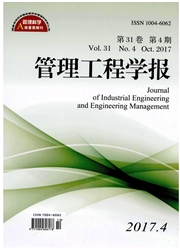

 中文摘要:
中文摘要:
在多个规划期背景下,本文研究了由多个制造商、多个零售商和多个消费市场组成的闭环供应链网络的均衡问题,其中制造商存在库存能力约束并进行制造和再制造活动。特别地,对于再制造过程,考虑了产品寿命次数。利用规划期之间的库存转移和回收废旧品的再制造刻画规划期之间的联系,运用变分不等式、互补理论和对偶理论建立了各层成员和整个供应链网络的均衡条件。最后,结合固定步长的修正投影收缩算法对模型进行求解,并通过算例对有关参数进行了灵敏度分析。算例分析的结果表明:无论制造商是否具有库存能力约束,制造商和零售商的利润随着两次再制造转化率的变化均大致呈现线性关系;制造商的库存能力约束会改变制造商和零售商的利润,并使总利润有所增加但不会实现帕累托改进。本文的研究有望为闭环供应链及其网络均衡方面的研究提供一定的借鉴。
 英文摘要:
英文摘要:
Closed-loop supply chain (CLSC) management has become a hot topic in the academic and business communities in recent years. Many scholars studied the pricing strategies and production planning problems of CLSC from different perspectives. However, the majority of them are limited to static environment and chain structure. In fact, CLSC is a complex dynamic network. In terms of the function of the players, the network can be divided into various tires, such as manufacturer tier, retailer tier and consumer market tier. Moreover, the network parameters in CLSC often change over time. Under such dynamic environment, the decision-makers should consider how to deal with the change of supply and demand effectively. For example, the manufactures can hold inventory in order to cope with the price increase of raw materials or meet the increase of market demand. However, inventory capacities of a manufacturer are finite in practice. Thus, this factor must be embodied in the CLSC research. In addition, a typical product is likely to be remanufactured multiple times. As a result, this factor should also be considered in CLSC modeling. In this paper, we divide the making-decision time into several periods, and study a CLSC network equilibrium problem in the multi-period planning horizon. The network consists of multiple mutual competitive manufacturers, multiple mutual competitive retailers, and multiple consumer markets. All the manufacturers are involved in producing homogeneous products, collecting used products from the consumer markets at the end of each period and remanufacturing them. Every manufacturer has inventory constraints. Each retailer purchases products from various manufacturers to meet the demand of corresponding consumer market. The demand in each consumer market is a deterministic function of the sale price. Particularly, product lifetime is introduced to formulate the maximum times of manufacturing and remanufacturing. The relation between adjacent periods is described by inventory transfer. All the p
 同期刊论文项目
同期刊论文项目
 同项目期刊论文
同项目期刊论文
 The Closed-Loop Supply Chain Network Equilibrium with Products Lifetime and Carbon Emission Constrai
The Closed-Loop Supply Chain Network Equilibrium with Products Lifetime and Carbon Emission Constrai 期刊信息
期刊信息
